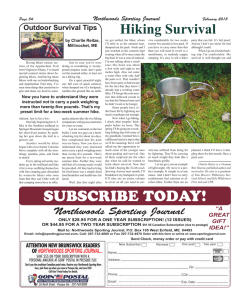
Download eBook Now!
Table of Contents INTRODUCTION ...................................................................................................................................... 2 CHAPTER ONE – WHAT’S ALL THE FUSS ABOUT? ........................................................................ 3 ZOMBIELAND .............................................................................................................................................................. 3 CHAPTER TWO – PREPARING FOR A DISASTER .......................................................................... 5 WHO YOU GONNA CALL? ......................................................................................................................................... 6 KEEPING IT IN THE FAMILY ..................................................................................................................................... 7 YOUNG ENOUGH TO SURVIVE .................................................................................................................................. 7 CHAPTER THREE – SURVIVAL NETWORKING ............................................................................... 9 COMMUNITY EFFORT ................................................................................................................................................ 9 SOME PREFER THE SHADOWS .............................................................................................................................. 10 CHAPTER FOUR – STAYING PUT VS. BUGGING OUT ................................................................. 11 TAKING THE MINIMUM & MAKING THE MAXIMUM ......................................................................................... 11 AVOIDING DETECTION ON THE MOVE ................................................................................................................ 13 HOME BUNKERS ..................................................................................................................................................... 14 FALLOUT SHELTER FLAWS ................................................................................................................................... 15 CHAPTER FIVE – HOME FORTIFICATION AND DEFENSE ........................................................ 17 10 BASIC PERIMETER DEFENSES ........................................................................................................................ 17 LOCKING THE DOOR (AND MORE) ...................................................................................................................... 19 COVERING THE HIGH GROUND ............................................................................................................................ 20 CHAPTER SIX – THINKING OUTSIDE THE BOX .......................................................................... 21 A WEAPON IN EVERY ROOM ................................................................................................................................ 21 FULLY FUNCTIONING FURNITURE ....................................................................................................................... 22 KITCHEN SINK DEFENSE ....................................................................................................................................... 23 CHAPTER SEVEN – FIGHT OR FLIGHT ........................................................................................... 25 RULES OF SELF-‐DEFENSE ..................................................................................................................................... 25 HIT ’EM WHERE IT HURTS ................................................................................................................................... 26 CHAPTER EIGHT – SURVIVAL FIREARMS .................................................................................... 28 SURVIVAL GUN REQUIREMENTS .......................................................................................................................... 29 A LEVELED DEFENSE ............................................................................................................................................. 31 THE RULING ON RIFLES ........................................................................................................................................ 32 SURVIVAL KNIVES .................................................................................................................................................. 33 CONCLUSION – ARE YOU PREPARED? ........................................................................................... 34 Discover the best self-‐defense system based on successful street fighting tactics: http://www.TheSurvivalPro.com/go/streetfighting Page 1 Introduction It’s happening all around us. Hardworking individuals are trading their paychecks in order to turn their homes into fallout shelters, and they’re dedicating their free time to learning survival skills and self-defense tactics. It’s estimated that there are currently more than 3 million individuals in the United States alone that consider themselves “preppers,” who spend considerable time and resources preparing themselves for the worst. Every survivalist has his or her own idea of what form the impending apocalypse will rear its ugly head in, but most seem convinced the end of times are around the corner. Modern news media only adds to the hype and paranoia: Are hurricanes and tornados increasing in destructive magnitude? Can modern-day street drugs and viruses turn their victims into a zombie-like state? Will ancient predictions come to fruition, promising a polar shift or other environmental catastrophe on a global scale? Or will the masses simply rise up against hard economic times and unreliable political leadership, sending society down a road to anarchy? Before you read any further, learn how to tailor a disaster plan to your needs, protecting you and your loved ones in case of emergency. This free video will show you tips that could one day save your life: Watch the Video: Disaster Plan Secrets for Families http://www.TheSurvivalPro.com/go/familysurvival Discover the best self-‐defense system based on successful street fighting tactics: http://www.TheSurvivalPro.com/go/streetfighting Page 2 Chapter One – What’s All the Fuss About? Statistically speaking, it remains highly unlikely that the United States, Great Britain and other well-off Western nations would plummet into societal collapse. But that is not to discount the fact that society has been tested with precautionary warning signs. Hurricane Katrina in the Gulf Coast of the United States proved that manmade infrastructure is no match against the forces of nature. It also showed what lengths individuals and families are willing to go to in order to ensure their own survival when emergency responders abandon their posts and the government is too slow to react. This seems to be one of the most common threads in the survivalist mindset. Whatever type of disaster happens—and no matter when it occurs—we as humans inherently feel that we have our own best interests at heart and thus must be able to fend for ourselves. Too many times have local, state and federal governments failed to react in a timely and effective manner to ensure that the masses survive and order is restored. There is still concern that the government may interfere with our livelihoods and basic liberties, as is already prevalent with gun-control laws and widespread surveillance of the private sector. Yet, the major concern seems to be our fellow citizens, who we fear will be motivated to rob, kill and steal in order to survive during a societal or economic collapse. Zombieland The ever-increasing presence of zombies in television, movies, books and video games indicates that people are shifting their fear from the government and their cover-ups to something more visible and relatable: their peers. Discover the best self-‐defense system based on successful street fighting tactics: http://www.TheSurvivalPro.com/go/streetfighting Page 3 Try and visualize a prison riot: angry mobs of people that cannot be reasoned with will only succumb to deadly force. This is basically the way that hordes of zombies are portrayed. So if a person gives an offhand response of “the zombie apocalypse” as the reason for their prepping mindset, they are using fiction to confirm their fear of an impending social disorder on a massive scale sparked by humanity itself. Cultural obsession with zombies has spread to the point of infecting the firearms and self-defense industries. You can now find shotguns, ammunition, crossbows, edged-weapons and other equipment and gear marketed as ideal for fighting zombies and surviving the apocalypse. Whether the producers and consumers of these products intend for them to be used for purposes of enjoyment or actual practicality cannot truly be determined. And whatever your feelings on the zombie craze, the widespread cultural fascination further proves that society is being desensitized to death and destruction—for better or for worse. Discover the best self-‐defense system based on successful street fighting tactics: http://www.TheSurvivalPro.com/go/streetfighting Page 4 Chapter Two – Preparing for a Disaster No matter the reason for crisis, the concepts for survival remain the same. And though we are not yet forced to live in terms of day-to-day survival as a result of a real imminent danger, widespread civil unrest is a plausible threat if societal and natural forces continue to push the masses past their breaking point. Should a crisis occur, you must immediately be prepared to provide four basic provisions: water, food, medical supplies and the general shelter and security needs for yourself, your family and your survival party when they are unavailable from their typical suppliers. Food and water. Your body needs these to survive. Food and water are your top priority, and securing anything else without them will be a futile exercise. Shelter. If the incident you face occurs during a harsh winter blizzard, hurricane, tornado or other severe weather condition, shelter becomes a heightened necessity. You may be forced to remain mobile in a survival scenario, which will require you to become familiar with shelter-building techniques. Medical supplies. Injuries, both minor and life threatening, are more likely in survival situations. Those requiring prescription medications for daily well-being should be prepared with extra quantities in ready-to-go locations. Security. Protection of yourself, your family and friends and your supplies are of utmost importance to ensure survival. Civil unrest will bring about unruly mobs intent on taking what you have, and you must be prepared to protect what is yours. A large part of this book will focus on this often-missing component from many government-issued preparedness guides: defending yourself, your home and your supplies using multiple conventional and non-conventional methods. Discover the best self-‐defense system based on successful street fighting tactics: http://www.TheSurvivalPro.com/go/streetfighting Page 5 Who You Gonna Call? During a widespread emergency, especially if caused by a natural disaster, you must be prepared to go without many things that are taken for granted on a daily basis. The police and military may not be able to respond for any number of reasons, including their own need to keep themselves and their families safe. This is if you can even reach a telephone or find cell service to call for help. Be prepared to go without the basic amenities in a “stuff” hits the fan (SHTF) scenario: 1. Water 2. Electricity 3. Transportation 4. Medical facilities 5. Communications (e.g., cell phone grids, landlines) 6. Natural gas and fuel 7. Groceries and hardware 8. First Response units 9. Public safety When access to these things becomes limited or cut off, you must take measures into your own hands to protect and provide for yourself and your family. The majority of people will lose their moral compass in the event of a total societal breakdown, which will require you to ask yourself what you are prepared to do to ensure your survival versus theirs. Your neighbors and friends will feed off their own primal survival instincts to keep themselves alive, further complicating the steps you must take. Discover the best self-‐defense system based on successful street fighting tactics: http://www.TheSurvivalPro.com/go/streetfighting Page 6 Keeping It in the Family Survivalists prepare themselves in self-defense under the assumption that the police and military may not be there to provide protection. Not to mention that should there be an outbreak of civil disorder, you will be the minority as a lawabiding citizen, and you will ultimately be on your own to protect yourself. This means you will need as much support as you can muster to ensure your survival, including but not limited to involving your family in your home preps and selfdefense training. As the cliché goes, “A chain is only as strong as its weakest link,” and your family or group is only as strong as its youngest or poorly trained member. You will want to have as many strategic advantages as your finances, property and physical abilities allow. But a larger family means more mouths to feed and more lives to protect—just as a larger property or home will require more fortification, supplies, weapons and guards to keep defended. However, having a larger family or group on your side also decreases the amount of work that falls on your shoulders to keep everything in order and protected. Young Enough to Survive The issue remains controversial as to how old a child should be before they can handle a weapon and begin learning about self-defense. Most agree that if a child is old enough to distinguish friend from foe and can hold a weapon proportionately sized to their body, squeeze the trigger, and manage the effects of recoil, then he or she is old enough for self-defense and should be issued a weapon (if available) during a survival crisis. Discover the best self-‐defense system based on successful street fighting tactics: http://www.TheSurvivalPro.com/go/streetfighting Page 7 Seeing as boys as young as 14 and 15 have lined up to volunteer in defense of the U.S. since the Revolutionary War all the way up to Korea, this concept of the youth defending themselves during perilous times is not new. It’s ultimately up to you as a parent to educate your children between right and wrong and what extreme circumstances could dictate justifying extreme actions, even of violence. Discover the best self-‐defense system based on successful street fighting tactics: http://www.TheSurvivalPro.com/go/streetfighting Page 8 Chapter Three – Survival Networking Do you consider yourself a lone wolf? Do you trust yourself more than anyone else to ensure your survival? Many preppers intend to stick to their own guns (and those of their immediate family) when disaster strikes. However, there are many individuals who see the value in having a support group to rely upon in the event of an emergency. Networking can be a much more practical option to help you survive than trying to manage everything yourself. Perilous times require people to go above and beyond their normal physical and psychological capacities, often to the point where you may become too weak to defend yourself. Belonging to a network of like-minded individuals who can pick up each other’s slack and contribute to the defense of the community could save your life. But don’t wait until the day after the disaster to knock on your neighbor’s door—the welcome isn’t likely to be warm. Community Effort The ability to establish a survival network depends largely on the area you live in and the layout of the property and homes in your neighborhood. If you live in an area where you know you can benefit from your neighbors resources and skillsets—and you can contribute your own to others—it’s important to establish an agreement well in advance of a disaster. You can begin implementing strategies for defense and operations to collect and distribute communal resources so that everyone in the group benefits from the work of others. The chances of forming a survival community are more likely in rural areas or open neighborhoods where properties are rich with natural resources and land that everyone can cultivate and harvest. Rural and suburban areas are also more likely to be home to blue-collar workers with a diverse array of skillsets. Discover the best self-‐defense system based on successful street fighting tactics: http://www.TheSurvivalPro.com/go/streetfighting Page 9 Perhaps your cache of supplies is lacking in something your neighbor has in excess; a survival network will give you the ability to trade. And if you have neighbors that are in the police or military and you don’t have access to weapons or training, you may be inclined to seek their defensive support in exchange for your own resources or skills. Many neighborhoods throughout the world are a heterogeneous mix of welders, electricians, contractors, gardeners, mechanics, truck drivers, cooks and other individuals skilled in a specific trade or craft. Pooling these resources can help many stay alive after a disaster. Some Prefer the Shadows Not everyone wants to be part of a group or agrees that networking is the best route to take to ensure survival in the aftermath of a disaster. Many survivalists would rather no one know what preps they have made as they believe others may attempt to exploit them for what they have. Even your best friends and neighbors will become desperate after a disaster and may not hesitate to come after your supplies, guns and ammo if they know your home is well-stocked. To that tune, putting iron bars around your windows, digging trenches and having lookout posts on your roof will make your home stick out like a sore thumb. Not only is it possible that those close to you will come after your stores, but word may also spread and attract additional outsiders to your property. The lone wolf mentality is very much a matter of personal attitude and circumstance. If you have a large family or very limited amount of resources, or if your resources are particularly valuable as a survival commodity, you may be inclined to hide their existence and keep to yourself in order to ensure their protection. Discover the best self-‐defense system based on successful street fighting tactics: http://www.TheSurvivalPro.com/go/streetfighting Page 10 Chapter Four – Staying Put vs. Bugging Out Most people preparing for a disaster situation support one of two philosophies for survival: sheltering in place (staying in) or hightailing it out of there (bugging out). Some people have the resources and abilities to have a plan that involves a mixture of the two. Whether or not you decide to stay put and defend your home depends on a variety of factors. Do you live in the county, suburbs or city? Are your neighbors potential threats or allies? Do you have the resources to form a defensive perimeter and weapons and skills to protect your property? Beyond the short term, does your property allow for you to live comfortably and safely for an extended period of time? Are there any individuals in your family or party, or other adverse circumstances, that completely prevent you from bugging out? Depending on how you answer these questions, you may need to consider relocating when disaster strikes and face the possibility of taking as many survival-sustaining items as you can carry. In urban and high-crime areas, you’ll face additional threats whether you decide to stay put or bug out. If you live in part of a shared building, such as an apartment complex, condo or other residence, your chances of making it outside are severely reduced as panic and chaos will overcome most people’s ability to reason and act efficiently. Have an escape plan and route laid out to be ready to leave at the first sign of trouble. Taking the Minimum & Making the Maximum No matter what your intended survival plan, you need to have emergency gear at the ready to ensure your short-term survival (at the very least). What you must understand from the onset is that you will not be able to take everything with you. People that survive real-world disaster situations often have access to very few, if Discover the best self-‐defense system based on successful street fighting tactics: http://www.TheSurvivalPro.com/go/streetfighting Page 11 any, tools and resources to help them survive; yet, they must make the most with what they have. Your load will be limited to what you can carry on your person or store in your vehicle. If you are traveling with multiple individuals or vehicles, you can and will need to carry more food, medical supplies and other life-sustaining supplies. Below is an example list of some of the most practical, storable and versatile items to include in survival kit. The list is not comprehensive, but it covers the basics that will help you sustain yourself for short-term survival and self-rescue. Every member of your survival party should have his or her own kit containing: A knife (large models are best, but quality folding knives may be sufficient) LED flashlight (mechanically operated or with extra batteries) First-aid kit Paracord Compass Local map Multi-tool Duct tape Waterproof matches and/or fire starter Water filter/sanitation tablets Signal mirror Survival blanket Emergency whistle Cook stove Sewing kit Poncho or lightweight rain jacket Toilet paper Discover the best self-‐defense system based on successful street fighting tactics: http://www.TheSurvivalPro.com/go/streetfighting Page 12 Zip ties Resealable bags Crow or pry bar Mess kit Change of clothes Sunglasses Work gloves Plastic sheet or tarp Toiletries These are just some of the basics that most peppers include in their disaster survival kits. Sticking to the items on this list and following the mantra of minimalist survival will keep you alive until you can find refuge or are rescued. Avoiding Detection on the Move In the event you do decide to bug out, you are going to want to draw as little attention to yourself as possible. Depending on the type of disaster and its aftermath, being out in the open could put you at risk to both environmental hazards and human threats. The latter may be an unruly mob with intent to capture, kill or steal from every survivor they encounter in a post-disaster wasteland. Keep in mind there is a difference between taking cover and being concealed. Cover is some kind of barrier, manmade or natural, that can protect you against bullets and help hide your position. Cover can come in the form of a tree, a vehicle, a concrete wall or the corner of a building. On the other hand, concealment only hides your position without offering protection. Tall grass, shrubs or other natural foliage are often associated with Discover the best self-‐defense system based on successful street fighting tactics: http://www.TheSurvivalPro.com/go/streetfighting Page 13 concealment. In any case, you should always seek cover during survival situations, especially when under attack, and only resort to concealment if cover is unavailable. But not all cover is going to protect you, depending on the type of weapons and rounds being fired your way. A cinderblock wall may stop most handgun and rifle fire, but a high-caliber round will have no problem obliterating the entire structure. Accordingly, trees, dirt mounds and the flimsy metal of car doors will eventually be chewed up by gunfire and leave your position exposed. In general, you should strive to keep a low profile when on the road in a postdisaster world. Don’t let anyone know where you are going. Move efficiently and constantly, change camp frequently, and always have someone one watch over your perimeter. Home Bunkers When it comes to keeping your family and your turf defended during a crisis situation, the best offense is a good defense (as the saying goes). The options are endless when it comes to fortifying your home and perimeter against an invasion, a mob of intruders, or any unwanted activity on your property. Some preppers swear that a fortified bunker, a well-stocked arsenal and a cache of food, water and other survival items are the keys to surviving a disaster. Unfortunately, not everyone has the extra cash, property space and skillset to acquire these items, nor does everyone agree that this is the route to take. There are manufacturers popping up across the United States and Europe that specialize in building in-home, underground, bug-out bunkers, many that are equipped with enough supplies to sustain a family of four for a year or longer. A well-fortified bunker would certainly give most families peace of mind in the event Discover the best self-‐defense system based on successful street fighting tactics: http://www.TheSurvivalPro.com/go/streetfighting Page 14 of a disaster, knowing that they have a few weeks’ or even months’ worth of supplies to give them an edge over the non-prepared. While some of these new survival concepts are quite impressive in design and function, they are often entirely too costly and impractical to install for the average homeowner or family. The choice is yours, but your money could easily be put to use fortifying your home in less-conventional ways and learning proper survival and self-defense skills so you don’t have to bury your head in the sand in a worst-case scenario. Fallout Shelter Flaws Though proponents of fallout shelters think them to be nearly impenetrable, this is not the case. Rather than building their own, many preppers purchase prefabricated bunkers that are either buried underground or positioned in a certain landscape backdrop that forms a defensive perimeter. These capsules can be shipping containers, school buses or specifically designed survival pods that can be packed with food, water, weapons and supplies. Although water is always said to be the most critical component for survival, oxygen is really the most vital bodily need. For that reason, bunkers need to be outfitted with multiple ventilation systems to circulate fresh air and release dangerous carbon monoxide. No matter how much you try to hide them, these tubes, hoses and vents will be the most vulnerable point of your shelter. In the event an intruder makes it past your perimeter defenses and reaches your shelter walls, he or she will likely be intent on one of two things: eliminating whatever threat lies inside and moving on, or taking everything you have and potentially claiming your shelter as their own—neither of which is favorable for you and your family. Discover the best self-‐defense system based on successful street fighting tactics: http://www.TheSurvivalPro.com/go/streetfighting Page 15 Your bunker may be bulletproof, have flame-retardant walls, and withstand high amounts of pressure, but anything that obstructs your ability to breathe inside becomes life threatening. All of your preparations could become futile should an attacker attempt to flush you out of your shelter via a ventilation port. This could come in several forms: 1. Smoke – The most likely method, one smoke grenade would do the trick, as would smoke diverted from an outside fire source. 2. Fire – Gasoline or another flammable liquid could be poured in or around your shelter and lit from the outside. 3. Water – Hopefully your shelter was built to withstand inclement weather, but it’s possible to flood the inside via the ventilation system, especially if the disaster results in flooding (though this method remains unlikely). 4. Explosion – Very few individuals will have access to hand grenades and other conventional explosives in a survival situation, but homemade alternatives could be dropped into your bunker or used to breach the walls or doors. 5. Earth – Your shelter could be bulldozed, and you could be buried alive in dirt or sand if your invader had access to the right equipment. Blocking the ventilation access points with dirt and debris would be enough to slowly drain your shelter’s oxygen supply. Discover the best self-‐defense system based on successful street fighting tactics: http://www.TheSurvivalPro.com/go/streetfighting Page 16 Chapter Five – Home Fortification and Defense There are many more perfectly sound and affordable methods to turn your home (or a section of it) into a secure and defendable space. For property owners, the best technique is to start on the outside and work your way in, establishing a solid perimeter of alarm systems, diversions and obstacles to prevent intruders from reaching your home. Those living in urban and densely populated buildings and neighborhoods may have less of a perimeter to defend, but your close proximity to dozens of other individuals trying to survive leaves you more vulnerable to attack, thus giving you even more reason to create a system of external defenses. The larger your property and the fewer neighbors you have, the more advantages you have to defend your home. A large and open property layout gives you better visibility of your surroundings and more area to establish barriers and defensive installments to deter invaders. There is certainly an argument to be made for spending tens or hundreds of thousands on a piece of land with access to natural resources rather than a garage-sized doomsday shelter, which could become your tomb. 10 Basic Perimeter Defenses How you decide to bolster your home security is only limited by your imagination and ingenuity, as survival is all about making the most out of whatever you have. The options are endless, including: 1. Hedgerows – Thick hedgerows and thorny thickets have been used as natural defenses in warfare for centuries. If nothing else, they can slow down any invader on your property. Discover the best self-‐defense system based on successful street fighting tactics: http://www.TheSurvivalPro.com/go/streetfighting Page 17 2. Conventional alarm systems – Electric alarms, motion detectors and Gerryrigged systems using bells, tin cans or other noisemakers can alert you to the presence of invaders and potentially deter them continuing forward. 3. High walls – The higher and thicker, the better. Cinderblock and brick walls can be destroyed by vehicles or explosives, but they offer solid protection against gunfire and can halt an attack altogether. 4. Fencing – Simple chain link fencing, especially when rigged with barbed wire or an electric current, can be set up around an entire perimeter as an effective primary or secondary defense. 5. Trenches and dirt parapets – Armies have been digging trenches in battle for centuries as a means to slow down personnel and vehicles. 6. Moats or natural water runoffs – Building a moat is a serious undertaking, but all those medieval castles used water to deter invaders because it worked. 7. Security cameras – Even if they are fake or non-functioning, the sole presence of camera systems can be enough to scare away invaders. 8. Natural or manmade barriers – Boulders, downed or standing trees, and things like large earthenware pots, old appliances and other bulky contraptions can be strewn about your property to slow down people and vehicles. 9. Snares, traps and pits – Creating these can take some know-how, but a good trap can be used to maim human invaders the same as they can be used to catch game. 10. Attack animals – Even the most docile dog can alert you to the presence of an intruder on your property. You can go the extra mile by training your dog(s) to attack on command. You should explore and experiment with any method that may prevent a threat from reaching the safety of your home or shelter. Especially if you have decided to stay put and defend your turf no matter what chaos is going on outside, you’re Discover the best self-‐defense system based on successful street fighting tactics: http://www.TheSurvivalPro.com/go/streetfighting Page 18 going to have to learn how to effectively batten down the hatches and use what you have to turn your home into a fortress. Locking the Door (and More) Hopefully your home is already equipped with storm-grade doors that have more than one deadbolt lock. If you can afford the upgrade, shatterproof and bulletproof glass windows are great to have. But even old wooden windows can be screwed or bolted into their frames; then Plexiglas, wire mesh and iron bars can be added to protect the opening. Sliding glass doors are one of the most vulnerable entry points and are difficult to defend. At the very least, they should have a dowel track lock and some kind of plate screwed into place to prevent the door from being lifted off its tracks. You could go the extra mile to paint the glass or cover it in some kind of protective material to obscure its presence. A popular and affordable method of adding an extra layer of defense to the home is to line your walls with sandbags. Militaries use sandbags not only to defend against combat, but also to protect buildings, homes and bases against the effects of natural disasters. They are cheap and easy to mass-produce, and a few layers is enough to stop a bullet. You can simply purchase the sacks yourself, fill them with sand or dirt from your property, and stack a row or two on the inside or outside of your home’s walls. These cheap and practical strategies will help defend your home and family from outside gunfire and require an intruder to do some heavy lifting to breach your walls. Keep in mind that the more work you do ahead of time to cover your bases, the more likely you are to remain ahead of potential enemies and come out on top. Discover the best self-‐defense system based on successful street fighting tactics: http://www.TheSurvivalPro.com/go/streetfighting Page 19 Covering the High Ground Conflicts and disaster situations throughout history have proven that higher ground can provide a distinct advantage for whatever human or environmental threats you may face. During hurricanes and tsunamis, victims are often forced to retreat to the upper levels or roofs of their homes or residential buildings to flee from the effects of flooding. In military engagements, the forces positioned atop a hill or ridge often have a distinct advantage over their opponents below. No matter what measures you take to defend your property and the lower levels of your home, preparing the upper levels and roof can also give you a distinct edge. The height gives you a greater line of sight, which can allow you spot an enemy from a distance and potentially eliminate them before they reach your home. If you can access your roof, you should consider making a protective outpost and assigning a member of your family or group as a lookout. Like a basement or crawlspace, the roof could also serve as a last-ditch location in the event your home is breached. Think about the Home Alone movies: if a young Kevin McCallister (played by McCauley Culkin) could deter bandits Harry and Marv by raining bricks and paint cans from above, you should be able to come up with your own simple ways of defending your home from the roof. Things like flowerpots, construction materials, tile and lumber can be stored on the roof and discharged upon intruders below, causing serious physical damage. The same tactics apply to the windows on the upper levels of your home. Discover the best self-‐defense system based on successful street fighting tactics: http://www.TheSurvivalPro.com/go/streetfighting Page 20 Chapter Six – Thinking Outside the Box When most people think about self-defense in a survival situation, they automatically assume that guns, ammo and other destructive weapons will be at their disposal. We’ll look into some requirements of survival firearms and some of the best examples in Chapter 8, but for now we are going to address some lessconventional methods for defending your home and your person when SHTF. In order to secure your home in an affordable and effective manner, you need to start thinking both practically and creatively. The same is true if you are forced to hit the road during a crisis; opportunities and objects will present themselves to you, and you must decide what can be put to use to ensure your safety and survival. A Weapon in Every Room Unknowingly, most homeowners have dozens of objects around the house that could potentially be used for self-defense purposes. You can probably start identifying potential weapons off the top of your head, but simply taking a walk around the house, garage and shed, examining everyday objects and brainstorming unconventional ways to use them will yield potentially lifesaving results. In the event you are forced to bug out during a crisis, the area around you may become a wasteland full of items that can serve a purpose beyond their intended function. Staying put during a survival situation means making the most of the resources around you, adapting them to suit your needs and having them available at a moment’s notice to defend yourself and your family. Again, you must think outside the box to identify things that are easily accessible and can be improvised in advanced to be used when disaster strikes. After all, defense of Discover the best self-‐defense system based on successful street fighting tactics: http://www.TheSurvivalPro.com/go/streetfighting Page 21 yourself and your home means being in a constant state of readiness—not waiting for chaos to unfold around you. Fully Functioning Furniture Many preppers fail to see the strategic and tactical value of the furniture, appliances and equipment in their homes. Though you may not be able to turn an armchair into a weapon, some of the big and bulky items in your home do have value when it comes to defense. In emergency situations, washers and dryers don’t have to be limited to the laundry room, nor do refrigerators need to stay put in the kitchen. These large appliances can be placed against doors, windows and other weak points around your home to act as barriers, while still functioning as intended. Sofas, bedframes, dining room tables and other heavy wooden or steel furniture can also be positioned in strategic areas, or disassembled to board up windows or block entry points. Most of the damage-inflicting items are found in kitchens, garages and sheds. Kitchens drawers and cabinets hide an assortment of knives, heavy pots and pans, rolling pins, mallets and other instruments that can cause serious damage if wielded as weapons. The garage and shed are home to things like shovels, axes, garden hoes and power tools, which (as seen in the movies) can also inflict incapacitating trauma. Any gasoline, oil, propane or other flammable substances will not only serve their intended purpose as sources of fuel, but can also be deployed to create diversions or cause serious damage to intruders on your property. Discover the best self-‐defense system based on successful street fighting tactics: http://www.TheSurvivalPro.com/go/streetfighting Page 22 Kitchen Sink Defense Knives may be the go-to kitchen items for offensive hand-to-hand fighting purposes, but there is a multitude of both offensive and defensive items located underneath the sink (or maybe in the laundry room or hall closet). Some items you may think to be space-takers include: Liquid soaps, detergents and floor cleaners – These cleansers, especially liquids that are transparent and odorless, can be poured over solid floors both inside and outside as a slippery trap to delay intruders. Spray cans – Anything that comes in an aerosol can be used just as you would use pepper spray. Aiming toxic chemicals in the eyes, nose and mouth of an opponent can make him think twice about continuing and give you additional time to go on the offense. If thrown or set up at a distance, the cans can be shot at to create a homemade smoke and chemical bomb. Other chemicals – Between the kitchen, laundry room, garage and medicine cabinet, you are bound to have some household chemicals that are highly flammable. These can be used in diversionary or offensive manners; be conscious that the blaze cannot threaten your home or shelter. There are many other less-conventional methods you could implement in your home to help beef up your security, and you are really only limited by your creativity and resources. Not everyone can afford the equipment and professional installation of modern home security systems so you may have to get crafty. A trip to a home improvement store with a few hundred dollars could supply you with a great deal of defensive materials and equipment. You don’t need to turn your entire home into a booby trap and deny the functionality of furniture, appliances and electronics in the pursuit of defense. Discover the best self-‐defense system based on successful street fighting tactics: http://www.TheSurvivalPro.com/go/streetfighting Page 23 Instead, you must look at everyday items for more than what they are and find ways to adapt them to be used in case of an emergency. By no means is this meant to discourage the value of guns, fallout shelters, storage caches and conventional perimeter security, as each of these can be essential components of surviving a disaster. But before you go out and spend hundreds or thousands on the latest survival gear, first take a look around your home and pick out what you already have on hand that could be put to good use. Discover the best self-‐defense system based on successful street fighting tactics: http://www.TheSurvivalPro.com/go/streetfighting Page 24 Chapter Seven – Fight or Flight The idea behind home prepping and bug-out survival is maintaining a constant state of readiness for a disaster situation and making the most of what you have, knowing you may be forced to leave the normalcy of your life behind. Although you now have a better idea of what you need and can use to bolster your home security or survive on the road, sometimes your best efforts won’t stop a persistent attacker, and you may be forced to defend yourself without a conventional weapon. Hand-to-hand combat should always be your last resort when it comes to stopping a foe, but you must be versed in some basic fighting skills in case you come face-to-face with one. Rules of Self-Defense Quite simply, there are no rules when it comes to survival. No matter what type of disaster causes a breakdown of society, every person affected will begin living by survival of the fittest. If you want to live, you must use everything at your disposal and use every dirty trick in the book to stop your attacker. With that said, there are a few guidelines to follow to either avoid or win a fight. 1. Avoid dangerous situations – You will probably be safe in your home if you have installed the proper perimeter defenses. If you’re bugging out or forced to venture out in search of supplies, avoid situations and locations that seem dangerous. After all, the best self-defense is avoiding conflict altogether. 2. Observe everything – You must sharpen your senses in a survival situation and be aware of everything and everyone around you. Learn how to identify body language to determine the intent of a potential attacker. Discover the best self-‐defense system based on successful street fighting tactics: http://www.TheSurvivalPro.com/go/streetfighting Page 25 3. Portray confidence – Think of your attacker like a shark. If they can sense fear or weakness in you they will be more likely to attack. Confidence comes with training and experience, but you can still fake it ’til you make it. 4. Strike first – If you are forced to fight, be the one to throw the first blow, and make it as hard-hitting as possible. Your mission is to take down your opponent and take the fight out of her both physically and psychologically. 5. Run – In a survival situation, you aren’t a criminal (or a wuss) if you flee from a fight. If you have the possibility to avoid physical engagement altogether, run away as fast as you can to a safe location. Otherwise, try and cause as much damage to your opponent as possible as to immobilize him then get away pronto. Hit ’Em Where it Hurts Become familiar with the pressure points located throughout the body as well as appropriate strikes that will trigger intense and incapacitating pain. The eyes, nose, throat and ears are especially weak. Don’t be afraid to gouge the eyes, punch the throat, or clap the ears with both hands— all effective ways to stop an attacker. An attack to the groin (on men in particular) is another option to consider if the opportunity presents itself. A strong strike to the kidney area can knock the wind out of most people, and a kick to the knee will send a large man tumbling to the ground. While throwing a punch or swinging a kick may give you the best reach, they are not the most damage-inflicting parts of the body to strike with. The elbow is actually the strongest point on the body, but it requires some extra dexterity and skill to use effectively. If you can get close enough to your attacker, an elbow is more likely to break the nose or trigger intense pain than a closed fist or foot. Women and children are less likely to be able to land an elbow strike against a large male attacker, but using it in combination with other strikes can cause some real damage. Discover the best self-‐defense system based on successful street fighting tactics: http://www.TheSurvivalPro.com/go/streetfighting Page 26 Striking with the knee and head are also alternatives to punching and kicking. Though they are also among the pressure points that are most sensitive to pain, they are also capable of being used to inflict the most damage. A head-butt to the nose of an opponent, or knee to the groin or stomach, can cause enough pain to buy you time to run away. Always try to stay in control of the situation and be the one to act first and (ideally) last. In the case an attacker rushes you, your time and options will be limited as to where and how to strike. If you have a moment to feel your opponent out and read the clues as to how she may strike, you can pick out the best place to attack based on her position. In other words, don’t overextend your reach to land a punch to the face if it is easier (and closer) to kick at your attacker’s knees. Keep in mind that no rules apply. Even if you have to kick, thrash, bite or claw your way out of the reach of an aggressor, you must try everything and anything to get away with your life. Taking a single self-defense class could supply you with the general knowledge and skills needed to get out of a fight, but practice makes perfect (as in all survival skills). Discover the best self-‐defense system based on successful street fighting tactics: http://www.TheSurvivalPro.com/go/streetfighting Page 27 Chapter Eight – Survival Firearms Contrary to popular belief, having any gun during a survival scenario is not better than having no gun at all. While some preppers make solid choices on dynamic weapons suited for survival, others simply rely on the weapons they already have for hunting, target shooting or home defense. Not to discount the merit of choosing these weapons for their intended purposes, but when it comes to protecting you and your family against angry mobs who will likely be using a similar hodgepodge mix of guns, they simply aren’t going to protect you effectively. You may be inclined to disagree and hold firm that any gun is worth having and putting to use when SHTF. Let’s consider three different weapons: a handgun purchased to protect your family and home during normal times of order, a shotgun used for duck or other game hunting, and a high caliber bolt-action rifle for big game hunting—all of which are among the most commonly owned and used firearms for recreational purposes. In areas where it’s legal, many individuals choose to purchase handguns to defend themselves and their families in the event of a home invasion. Since handguns perform their best at short ranges and in close quarters, using one in the rooms or corridors of your home should yield high effect on the target without damaging your home’s integrity. However, attempting to defend your entire perimeter against multiple assailants with only a handgun is basically equivalent to using a slingshot (unless you’re James Bond). Shotguns have their place in survival arsenals, but not all are created equal. Hunting shotguns come in several gauge sizes and can be loaded with multiple types of ammunition with varying degrees of damage potential intended for taking down different types of game. While you could continue to use these to provide food for your family after a disaster, must hunting shotguns make for impractical Discover the best self-‐defense system based on successful street fighting tactics: http://www.TheSurvivalPro.com/go/streetfighting Page 28 home defense weapons. They are often slow to fire and reload, and even the smallest birdshot-loaded shell could tear through the walls or appliances in your home if misfired. Large bolt-action rifles are perhaps the most impractical weapons for survival situations. They take the most amount of time to assemble, sight on target, fire and reload than any other type of weapon. If you have a well-fortified home and the ability to protect it with multiple guards, a sniper-style rifle would make a good addition to your perimeter defense if positioned atop a roof. However, as primary survival weapons they are essentially useless—stick to moose hunting in Alaska. Survival Gun Requirements Survival guns need to be versatile, dynamic and capable of working effectively at multiple ranges. They should also meet the following five basic requirements: Reliability – The most futuristic-styled, tactical gun that comes pre-rigged with high-tech scopes and laser sights is not going to give you the best bang for your buck in a survival scenario. Fancier isn’t always better. You want a gun that will fire with the same accuracy and precision every time, even after sitting in storage or being buried underground for extended periods of time. More often than not the most simplistic, industrial-looking guns are going to be more reliable than those with all the gadgets. It shouldn’t need to be broken in like a combat boot; it should fire straight and true right out of the box. Toughness – The gun you rely on in the aftermath of a disaster should be tough, rugged and able to withstand a beating without suffering from functional damage. This is especially true if you decide to bug out or are forced to evacuate because you won’t have the luxury of keeping your gun properly stored and maintained while on the move. The best survival guns can be fired in wet, dusty and debrisfilled conditions and still perform with deadly accuracy. You don’t want a gun that Discover the best self-‐defense system based on successful street fighting tactics: http://www.TheSurvivalPro.com/go/streetfighting Page 29 requires frequent replacement of small parts as these will be extremely limited in times of chaos. Compactness – Whether staying put or bugging out, the weapons you select should be lightweight, convenient to carry and accessible when you need them most. Heavy bolt-action rifles and machine guns, while capable of inflicting serious damage, are overly cumbersome and too bulky to wield. Particularly if you plan on getting your family out of dodge, each member will be required to carry as much water, food and other supplies as possible. The last thing you need is a large, heavy weapon that will hinder your ability to stay light on your feet while on the move. Accordingly, you want something that is comfortable to carry and easily maneuverable in tight spaces and close quarters, whether inside the walls of your home, in the bush or in an urban center. Simplicity – The best survival guns are easy to operate. Remember that you may be equipping your children with a firearm, which should be relatively straightforward to operate. Loading the weapon, clearing rounds, flipping the safety on and off, and squeezing the trigger should be simple enough for combat veterans and eleven-year-olds alike. You may be inclined to keep your weapons disassembled and hidden as to remain safe, but they should be easy to reassemble, load and fire for purposes of self-defense with minimal time and energy. Stopping Power – Survival guns are meant to be multipurpose and must be effective at the various tasks assigned to them. If a breakdown of society results in civil unrest, there’s no telling how many enemies you may face or how wellequipped they will be in terms of firepower. Some guns can be highly effective at picking off individual targets but are less efficient when facing a mob. When defending your home, you’ll want something capable of addressing threats around your perimeter upwards of about 200 yards. The same goes for bugging out: You will want a weapon that allows you to put a greater distance between Discover the best self-‐defense system based on successful street fighting tactics: http://www.TheSurvivalPro.com/go/streetfighting Page 30 you and your targets. A survival weapon should have both a versatile range and a large-capacity magazine in order to be effective. A Leveled Defense Just as not every gun is effective for survival purposes, no single survival gun will provide unlimited protection at multiple levels of threat. That’s right: There is no ultimate survival gun. Instead of looking for the holy grail of weapons, those with access to firearms should consider obtaining multiple types of firearms that are most effective at a specific range. Bugging out will limit your capacity to carry multiple firearms and enough ammo, but fortifying your home gives you a chance to layer your defenses. The layered defense system has been in practice since the origins of warfare. Medieval armies created catapults and trebuchets for long-range attacks, used longbows and crossbows against medium range targets, and relied on swords, axes and shields at close range. Even the modern soldier has multiple levels of defense on his person when he goes into a combat. This often includes an assault rifle, a secondary submachine gun, a sidearm handgun and a combat knife—in addition to any launchers, grenades or explosives he may carry. Clearly the government isn’t investing millions in your own private arsenal, but you can still do your best to layer the variety and quantity of weapons to defend your family. Strive to include weapons in the following three classes to maximize your security potential. 1. Long-range – Modern military snipers may be able to take out a target a mile away, but in a survival situation anything beyond 100 yards can be considered long-distance. If you can hit the bullseye or make a tight grouping at 100 yards, you are well off to defend your perimeter. There are numerous Discover the best self-‐defense system based on successful street fighting tactics: http://www.TheSurvivalPro.com/go/streetfighting Page 31 semi-automatic rifles using .308 or .30-06 cartridges that are highly efficient at long ranges and available to the modern consumer. 2. Mid-range – A small hunting rifle like a .22 caliber may fit well into this category, although there are more powerful rifles available. You will want something that is effective at quickly picking off multiple targets at distances between 30 and 100 yards. 3. Close-quarters – Anything within 30 yards can be considered close-quarter combat, as can hand-to-hand combat. Shotguns are most effective at short distances, but are not necessarily suited for close-quarter combat. Pistols and small-caliber carbines are the best weapon selections at short range. Keep in mind that if your target is this close, your chances of having to draw a knife or face her in a fight become more likely, and you must be prepared. The Ruling on Rifles Though you should strive to layer your security, the rifle still stands as the best type of gun for survival purposes. From the muskets used by our ancestors to the advanced assault weapons used by today’s infantrymen, rifles have always proven their merit in even the toughest of combat situations. Whether defending your home or bugging out, if you have to pick one gun, it should be a rifle. Even the most experienced shooters struggle to decide on which rifle is best suited for survival. After all, there are dozens of brands, models, loading styles, calibers and other factors to decide on when purchasing a quality rifle. As previously mentioned, the high caliber bolt-action varieties aren’t suitable for the average shooter in most scenarios. But generally speaking, rifles are incredibly versatile multipurpose firearms that could serve effectively in any part of your layered defense. Discover the best self-‐defense system based on successful street fighting tactics: http://www.TheSurvivalPro.com/go/streetfighting Page 32 Survival Knives Aside from a firearm, the most important and protective tool you can carry is a well-made fixed-blade knife. A sharp, full-tang blade made of quality steel can be used for a variety of survival purposes. On a defensive level, they can inflict serious damage if you run out of ammunition or are forced to go hand-to-hand with an opponent. Additionally, a quality knife will stand up to tough chopping, slicing, digging, prying and other day-to-day tasks. Many knives that have been used by military professionals for decades are also available to the average consumer and are favorites among the prepper community. Discover the best self-‐defense system based on successful street fighting tactics: http://www.TheSurvivalPro.com/go/streetfighting Page 33 Conclusion – Are You Prepared? The prepper movement doesn’t show any signs of slowing down. If anything, people are becoming more fearful of a multitude of possible (though unlikely) man-made or natural disasters that could fling society into a state of chaos. When SHTF, only determination and ingenuity will get everyone out alive. Like all things in life, being prepared and mentally ready for just about anything is better than remaining complacent. You should always have a plan, a back-up plan, and a back up to your back-up plan in order to protect your family and your home or to get them to safety in the event of a disaster. Accordingly, you should never stop practicing your survival skills: fire starting, shelter building, water collecting, game trapping and self-defense. Most people who survive harrowing events do so with the most limited of resources, but their determination and ability to adapt is what gets them out alive. Unfortunately, you can never be fully prepared. Not knowing when or what type of crisis will erupt, you can never be certain of what elements it’ll take to defend your home and your life. While there is no way to make you, your family and your property invisible and invulnerable, there are endless strategies, tactics and tricks that you can practice to help your family survive and strive in perilous and unpredictable times. Now that you know survival self-defense tactics, don’t forget to check out the free video that will show you the best way to formulate a crisis plan so you’ll keep cool under pressure. Important Video: Disaster Planning Secrets for Families http://www.TheSurvivalPro.com/go/familysurvival Discover the best self-‐defense system based on successful street fighting tactics: http://www.TheSurvivalPro.com/go/streetfighting Page 34 Watch these other helpful videos too: Upcoming food crisis alert http://www.TheSurvivalPro.com/go/noproblem What products will sell out fast in a disaster and what to do about it http://www.TheSurvivalPro.com/go/soldoutcrisis How to make your own energy system quickly and easily http://www.TheSurvivalPro.com/go/homemadeenergy These are all FREE videos so I suggest you watch them today so you can be better prepared for whatever may happen tomorrow. Discover the best self-‐defense system based on successful street fighting tactics: http://www.TheSurvivalPro.com/go/streetfighting Page 35
© Copyright 2025









